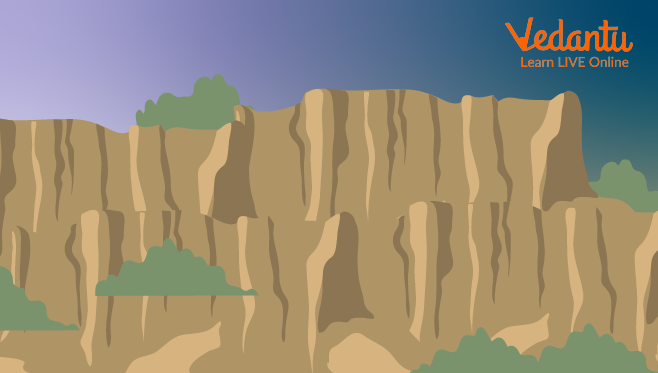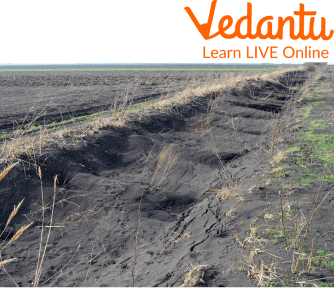




How Erosion Helps to Create Landforms
Our earth has many beautiful natural landforms which attract a ton of tourists every year. These landforms add to the beauty of the Earth. These special landforms are the result of phenomena like the movement of tectonic plates, erosion, etc. One such example is the Grand Canyon in the USA, Which is a very popular place.
In this article we are going to learn about erosion meaning, water erosion and types of erosion. The Grand Canyon is made due to erosion of water. Erosion also forms many sea stacks, sea caves, headlands and bays, arches, and other beautiful landforms. Let us study some facts about Erosion and try to understand what erosion is in detail.

Great Canyon, USA
Erosion Meaning
Erosion is a process in which things ( especially rocks, sediments, and soils ) break down into smaller pieces by the action of wind, water, or glacier and then transported from one place to another. So we can say that Erosion is the movement of particles away from their source. Example – Rock is broken down into smaller pieces by rain and this is transported to another place by wind or water itself.
Erosion is caused due to the forces of wind, water, glaciers, and gravity, as well as man-made causes, Like agriculture, gazing, mining, construction, etc. These forces lead to the breaking down of large materials and then transporting them to another place. The smaller particles are mostly transported in the downward direction due to gravity.
Let us understand erosion by water, wind, and glaciers in detail.
Types of Erosion
Water Erosion
Water erosion occurs when water carries pieces of soil or rocks themselves downhill. Water is one of the most powerful forces on earth; it causes a significant amount of erosion. Water can cause erosion by rivers, rainfall, and floods.
Waves also carry away small pieces of material. Rivers carve a snake-like structure when they flow down the mountain while causing erosion and the great Canyon is an example of such type of Erosion, formed by a river called the Colorado River.
Wind Erosion
The wind is also a very powerful force and does cause erosion in mostly dry areas such as deserts. Wind transports dust and sand particles from one place to another carrying them for a huge distance before settling down. The small sand particles which are being carried up by the winds hit big rocks at high speed which gradually makes the big rocks thinner and gradually break down.

Soil Erosion
Glaciers Erosion
Glaciers are a body of dense ice That is formed by fallen snow. Glaciers pick up the pieces of rocks as they freeze on the bottom of the glacier and they are carried away by flowing ice which further act as cutting tools. The moment of glaciers eroded lands and mountains and caused big features on mountains due to their heavyweight.
Effects of Erosion
Since we are learning some facts about Erosion, we know that Erosion makes so many beautiful landscapes on Earth but it also has some negative effects. Let us understand them.
Reduces Fertility of The Soil – Good quality soil is important for the growth of crops but when water washes away the top layer of soil there is a loss of nutrient-rich soil which leads to a decline in crop yield.
Environmental Impact- Erosion can cause the deposition of sand, pesticides, and other toxic materials into rivers which increases water pollution. These sediments disrupt the habitat’s natural balance, making it difficult for fish and other aquatic animals to thrive.
Damage- Erosion also causes natural disasters like landslides which affect the life of people, their houses, buildings, agriculture, and many other things.
Even though erosion is a natural phenomenon many human activities can speed up the rate of erosion which leads to many problems. Human activities such as deforestation, farming, and ranching have sped up erosion and caused many problems.
Prevention of Soil Erosion
Today one of the most serious problems faced by mankind is the Erosion of soil. Washing up a top layer of soil that is filled with nutrients causes low crop production and other problems. We can control soil erosion by following processes:
Reforestation-The best way to solve this problem is to reduce deforestation and plant more and more trees that resist wind and water from eroding the surface of the land.
Avoid Overgrazing- If so many animals graze at the same place then all grasses and vegetation will finish from that piece of land and it will cause soil erosion.
Use Plastic Sheeting- We can place plastic covers so that if a heavy wind blows it will protect the soil from erosion.
Proper Drainage- If there will be a proper drainage system then there will be no water blockage on fields. This will protect the soil from erosion.
Summary
Erosion is caused due to the forces of man-made causes like agriculture, grazing, mining, construction, etc. In this article we have shown you a soil erosion diagram which is very helpful in understanding the concept. Prevention of soil erosion is also explained in this article. Erosion has many harmful effects like reduction in fertility of soil, natural disasters like landslides, etc. We should control this soil erosion by planting more and more trees and by maintaining a proper drainage system. There are different forms of soil erosion which is already explained in this article. I hope this article is beneficial for you. If you find any difficulty you ask in the comments.
FAQs on Erosion - The Process of Eroding
1. What is erosion in simple terms?
Erosion is the natural process where soil, rock, or sand is moved from one place to another. Think of it as the earth's surface being worn away and carried off by forces like flowing water, strong winds, or moving ice.
2. What are the main causes of erosion?
The main causes, or agents, of erosion are powerful natural forces. These include:
- Water: Rain, rivers, and ocean waves can wash away soil and rock.
- Wind: Strong winds can blow away loose sand and topsoil, especially in dry areas.
- Ice: Glaciers, which are huge, slow-moving rivers of ice, can grind and move massive amounts of rock.
- Gravity: On steep slopes, gravity can cause soil and rock to slide downhill in events like landslides.
3. What are the different types of erosion?
There are several types of erosion, usually named after the force that causes them. The most common types are water erosion (from rain and rivers), wind erosion (common in deserts), glacial erosion (caused by moving glaciers), and gravity erosion (like rockfalls).
4. How is erosion different from weathering?
This is a common point of confusion. The key difference is movement. Weathering is the process of breaking down rocks into smaller pieces, but these pieces stay in the same spot. Erosion is the next step, where these broken pieces are picked up and moved to a new location. In short, weathering breaks it, and erosion takes it.
5. Why is soil erosion considered a problem?
Soil erosion is a major problem because it removes the topsoil. This is the most fertile layer of soil, rich in the nutrients that plants need to grow. When topsoil is lost, farmland becomes less productive, which can affect food supplies. It can also pollute rivers and streams with excess sediment.
6. How do human activities increase the speed of erosion?
Human activities can significantly speed up natural erosion. For example, when we cut down forests (deforestation), the soil loses the network of tree roots that held it in place, leaving it exposed to rain and wind. Overgrazing by farm animals and poor construction practices on slopes can also remove plant cover and accelerate the loss of soil.
7. Can erosion create anything new or is it only destructive?
While it is often destructive, erosion also plays a creative role in shaping our planet. Over millions of years, erosion has carved out incredible landforms like the Grand Canyon and created vast, fertile river deltas. So, while it wears down land in one place, it builds up new land in another.
8. What is a simple way to demonstrate how plants prevent erosion?
You can see this in action with a simple experiment. Take two trays of soil. Leave one bare and plant grass in the other. Once the grass has grown, tilt both trays and pour water over them. You'll notice that much more soil washes away from the bare tray, while the grass roots in the second tray hold the soil firmly in place.









